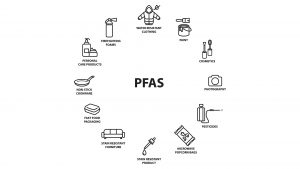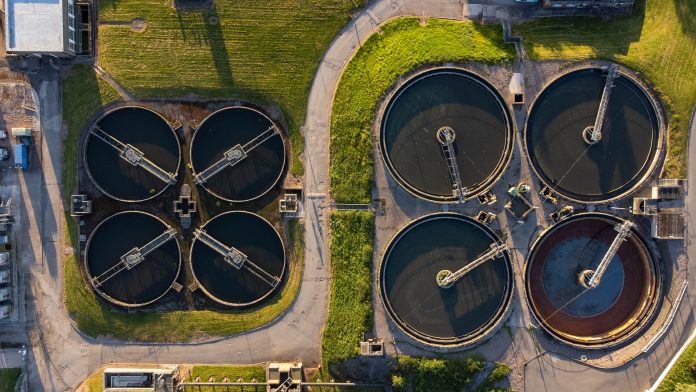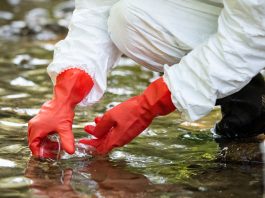Rafael Heredero, Policy Advisor at EurEau, explains how finding an alternative to PFAS chemicals should be key to the EU’s Green Deal and Zero Pollution Action Plan.
The European Green Deal, presented in December 2019, announces the EU’s intention to become the first climate neutral continent by 2050, resulting in a cleaner environment, more affordable energy, smarter transport, new jobs, and overall better quality of life.
Central to the Green Deal is the Zero Pollution Action Plan (ZPAP) which aims to cut air, water, and soil pollution to levels no longer considered harmful to health and natural ecosystems, thereby creating a toxic-free environment.
Water operators fully support this goal, but some developments seem to go in the opposite direction. They are seeing higher concentrations of several PFAS – the so-called ‘forever chemicals’ – in water.
About PFAS
Per- and polyfluoroalkyl substances (PFAS) are a group of around 5,000 chemicals that are used to make fluoropolymer coatings and products that resist heat, oil, stains, grease, and water. These PFAS chemicals are found in a variety of products (e.g., food wrappers, umbrellas, frying pans, paint, some textiles, and fire-fighting foam) as their water-repelling properties and durability are very useful.
PFAS either are, or degrade to, very persistent chemicals that can accumulate in humans, animals, and the environment and may cause adverse effects. They are widely present in the environment, soil, and food. Even more alarmingly, PFAS are found in almost all humans. Already, 14.26% of European teenagers tested in a recent study exceed the internal serum level of 6.9 µg/L PFAS – the European Food Safety Authority’s (EFSA) guideline value for a tolerable weekly intake of 4.4 ng/kg. Diet was found to be an important exposure determinant of PFAS.1
Research is ongoing as to whether all PFAS have a detrimental effect on our health and at which concentrations. While we are waiting for a definitive answer, it is better to be cautious – in line with the precautionary principle – and have a total ban on these chemicals.
It is not that simple though. Because PFAS are found in many widely used everyday items and industrial products, alternatives need to be developed to these potentially harmful chemicals. Indeed, any alternative to PFAS that comes to market should be guaranteed to be harmless. We sometimes hear the argument that many PFAS uses are irreplaceable and that we have to live with their negative consequences if we want to enjoy their benefits. But this would mean that, despite all the negative impacts, there should be no more room for innovation. This runs counter to the very idea of the Green Deal and its strategies.

Research and innovation are needed for the achievement of the Green Deal objectives
We believe effective research and innovation will be key to helping the EU achieve the Green Deal ambitions, accelerating and navigating the necessary transitions.
The EU plans to achieve this through Horizon Europe, the EU’s research and innovation programme (2021-2027). It will drive the necessary systemic changes to reach climate neutrality and ensure an inclusive ecological and economic transition. The Commission touts it as one of the drivers to “foster new technologies, sustainable solutions, and disruptive innovation and spread successful new solutions across Europe and the world.”2
This innovation surge should deliver some viable and environmentally progressive solutions to the PFAS problem.
Problems with PFAS
First, some PFAS have been proven to be toxic, while for the rest, there are many unknowns regarding their impact on health and the environment. For some of these substances, the tolerable weekly intake has been reduced by several orders of magnitude. We cannot exclude that the same will happen with other PFAS.
Secondly, PFAS pose a problem for water operators precisely due to their persistent and mobile qualities. Therefore, keeping PFAS from entering the environment is paramount.
Unfortunately, in the absence of effective control-at-source measures, PFAS are released to the environment through multiple pathways and may reach water resources. Due to their persistency, concentrations are likely to increase over time. The result is that drinking water suppliers will have to resort to costly extra treatment measures to comply with the limit values set in the 2020 Drinking Water Directive and national regulations.
The applicability of advanced (industrial) technologies to remove PFAS from our drinking water, based on physical separation or destruction techniques, is currently being investigated in pilot projects in laboratories. The results indicate that the large-scale removal of PFAS in water treatment plants will not be economically nor environmentally viable while being technically challenging.
At the same time, wastewater treatment plants are currently not equipped to remove PFAS from wastewater. PFAS are very resistant to biological treatment, and as a result, can end up in the effluent or in sewage sludge. Moreover, the very persistent perfluoroalkyl acids (PFAA, such as PFOS and PFOA) appear to be produced during the biological treatment process in the wastewater treatment plant (WWTP) following the degradation of polyfluoroakyl precursor compounds.
The most efficient way around the problem of potentially damaging PFAS entering the environment will be through finding alternatives to PFAS rather than innovating ways to remove them from the environment.
And there is a third reason to call for a rapid phase-out of all PFAS uses. The EU has so far failed to implement the polluter pays principle as enshrined in the Treaty on the Functioning of the European Union (TFEU) and emphasised in both the Chemicals Strategy for Sustainability and the ZPAP. The cost for extra water treatment or for the development of new, uncontaminated drinking water wells is not borne by those who sell PFAS, but by the water consumer.

Enacting appropriate measures and regulations
It is not all doom and gloom. If the European Union were to properly and fully enact the precautionary and control-at-source principles, as enshrined in the TFEU, we – as a society – would be a lot closer to achieving a safer and less polluted environment for everyone.
If these measures are insufficient to properly protect our health and the environment, Extended Producer Responsibility (EPR) must apply. EPR is a tool to implement the polluter pays principle. It means that producers of products bear financial responsibility or financial and organisational responsibility for the management of the waste stage of a product’s life cycle (Directive on Waste 2018/851). These same producers should bear a significant degree of responsibility for the environmental impacts of their products throughout the product life cycle and be financially responsible for rectifying any environmental damage they may cause.
Combined upstream (control-at-source) and downstream measures financed through EPR will be able to adequately tackle the full extent and scope of the problem.
At present, EPR extends only to products placed on the market. We believe EPR should encompass chemical substances too.
The European Commission has begun work on a revision of the REACH and the Classification, Labelling, and Packaging (CLP) Regulations. Both of these regulations address the production and use of chemical substances, and their potential impacts on both human health and the environment. As REACH encompasses potential environmental impacts, could the scope of EPR schemes be extended to include not only the impact of physical products, but also chemical ones? Perhaps doing so will make chemical producers and users reconsider their use and innovate environmentally less damaging alternatives.
There are many reasons why PFAS should be phased out. For individual PFAS, this has been done before under the POP (persistent organic pollutants) Regulation and also under REACH itself. REACH can work to limit their authorisation or restrict them altogether. Already today, we find a cocktail of different PFAS in many of our aquifers and soils, and in varying concentrations. The REACH restriction initiated by five European countries refers to all non-essential uses. This is a bold and ambitious step, provided the essential use cases are handled very restrictively. Otherwise, zero PFAS emissions into the environment cannot be achieved. The future safe and sustainable by-design rules (SSbD) will help foster innovation and bring less potentially harmful alternative products to the market.
The time is now for the European Commission and Member States to do more to better protect our water so that we can all have access to safe and reliable sources of water for years to come.
The EU institutions have a golden opportunity to do this through the Green Deal, the ZPAP, and updates in legislation such as REACH and the CLP. The ZPAP in its aim to achieve no pollution should go beyond a monitoring exercise and should take actions to reduce pollution at the source. Banning PFAS would be a major achievement. Horizon Europe, with its focus on innovation, can help find alternatives to products and chemicals that impede this goal.
Finding environmentally- and health-harmless alternatives to PFAS chemicals will also promote job creation.
The structures are already in place. We have tools across the EU that protect our water environment, such as the precautionary, control-at-source, and polluter pays principles, that are set out in the EU treaties. These need to be finally implemented according to the aims of the European Green Deal and its flagship initiative – the zero pollution ambition. We fully support this urgently needed interdepartmental strategy to protect our environment for generations to come.

About EurEau
EurEau is the voice of Europe’s water sector. We represent drinking water and wastewater operators from 30 countries in Europe, from both the private and the public sectors.
Our members are 35 national associations of water services. At EurEau, we bring national water professionals together to agree on European water sector positions regarding the management of water quality, resource efficiency, and access to water for Europe’s citizens and businesses. The EurEau secretariat is based in Brussels.
With a direct employment of around 476,000 people, the European water sector makes a significant contribution to the European economy.
References
1 HBM4EU Policy Brief ‘PFAS’ (June 2022)
Rafael Heredero
Policy Advisor
EurEau
www.eureau.org
https://twitter.com/eureau
Please note, this article will also appear in the eleventh edition of our quarterly publication.









